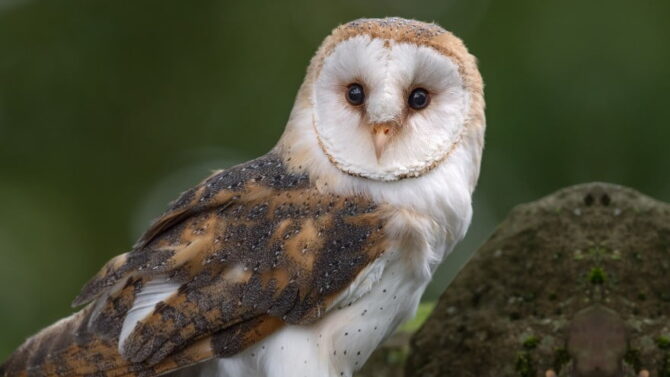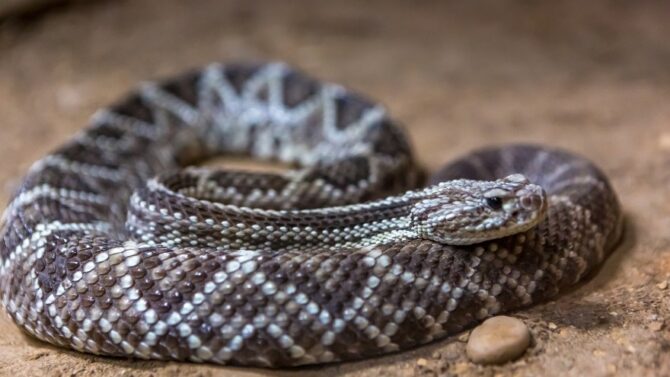Owls can be found in many countries around the world, including the United States. In the United States, owl species live in places like Minnesota.
The latter is located in the upper Midwestern region of the country, and it is the 12th largest U.S. state in terms of area.
It comprises habitats like prairies and deciduous forests that make a rich spot for many animals, including owls.
There are 12 species of owls in Minnesota, according to findings, all of which can be found in several other U.S. states. They include the great horned owl, Northern saw-whet owl, barn owl, and short-eared owl.
Continue reading to discover more facts about these birds and how to recognize the different species based on their appearance, sounds, and migratory patterns.
The 12 Species of Owls in Minnesota
1. Great-horned Owl
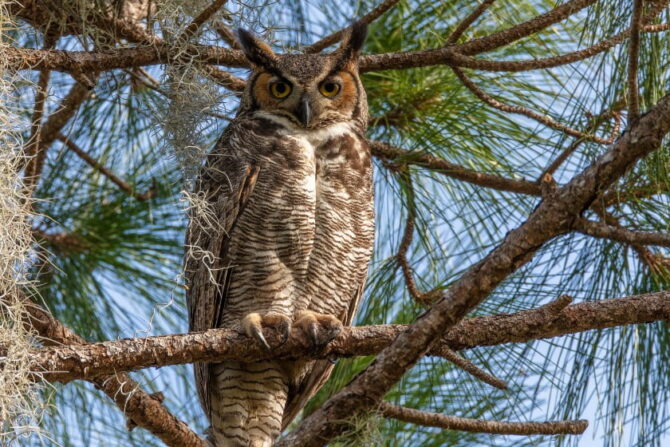
- Scientific name: Bubo virginianus
- Length: 18 to 25 inches
- Weight: 32 to 88 pounds
- Wingspan: 40 to 57 inches
The great horned owl kicks off our list. It is a large, adaptable bird that is the most widespread true owl.
It is also known as the tiger owl because of early references to it as a winged tiger or tiger of the air. The third name for it is the hoot owl because it hoots constantly.
The creature looks large and fierce, but as a true owl, it is also the perfect picture people have in mind.
It has ear tufts and yellow eyes, brown plumage, and bars on the lower parts of its body. Because of its color combination, it is a camouflage expert.
The hoot is its primary sound, but it also makes others like growls. Females are usually high.
This bird is nocturnal and is a carnivore. It relies on its hearing more than its smell, as the latter is very weak.
It feeds on rabbits, groundhogs, geese, birds, and even bigger raptors. Because of its size, it tends to consume a lot of food.
2. Barn Owl
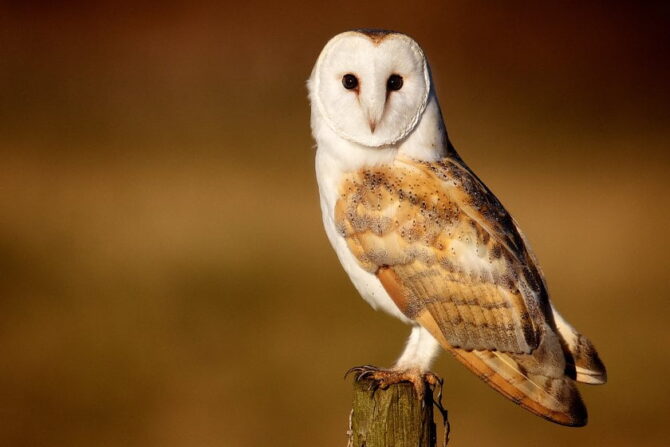
- Scientific name: Tyto Alba
- Length: 13 to 16 inches
- Weight: 14 to 25 pounds
- Wingspan: 40 to 50 inches
The barn owl bears this name because it lives in barns and abandoned buildings. It can be found all year in Minnesota but is more common in the southern side.
It is fully termed the common barn owl to set it apart. Other names it goes by are the church owl, ghost owl, monkey-faced owl, and some less flattering monikers like death owl and demon owl.
One noticeable trait of the barn owl is its heart-shaped face. It also has eerie, black eyes, which inspired the less flattering names mentioned above.
Its overall color is pale, and it has long wings with a square tail. Added to these are the feathered legs and the unusual flying pattern.
The barn owl doesn’t hoot. It rather shrieks, another eerie attribute. The call sounds like a shree, and you shouldn’t go too close to one when it shrieks to avoid getting your eardrums ruptured.
There are three types of barn owls. The one you can find in Minnesota and other American states is the American barn owl.1
This bird is nocturnal like other owls, though in some places, it can be seen hunting during the day.
It relies a lot on its strong sense of hearing in place of its sight. Its main meal consists of rodents and other small mammals, but it can also go after birds and reptiles.
3. Northern saw-whet owl

- Scientific name: Aegolius acadius
- Length: 7 to 9 inches
- Weight: 2 to 5 pounds
- Wingspan: 17 to 22 inches
The northern saw-whet owl is a tiny American bird that’s about the size of a robin. It is one of the smallest in its range.2
If you come across an owl in Minnesota that can easily fit in your palms, chances are it’s a northern saw-whet owl.
Its sound isn’t what you’d expect from a small bird, though. It comes out like a saw being sharpened on a whetstone, hence the name.
This sound serves as the best means to locate the bird. Once you hear what goes like “too too too“, you can be confident that a northern saw-whet owl is close.
It is high-pitched and very hard to miss. As it is more active during the late winter and early summer, these are the best times to see one.
The saw-whet is declining due to habitat loss, but there is still a lot in Minnesota that you can notice. Despite its small size, this bird is a hunter. It goes mainly after small mammals, especially rodents.
4. Barred owl
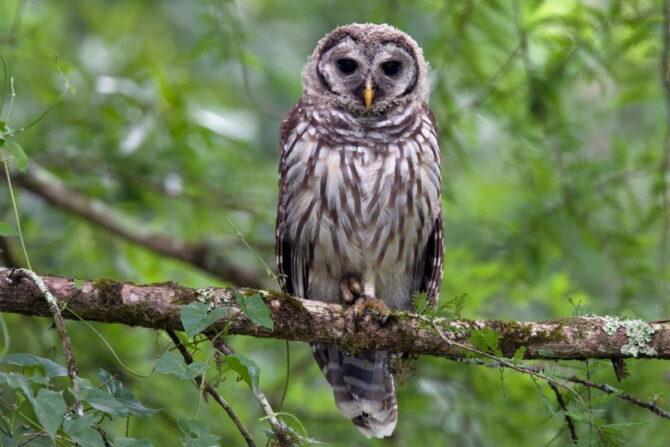
- Scientific name: Strix varia
- Length: 17 to 20 inches
- Weight: 16 to 37 pounds
- Wingspan: 39 to 43 inches
The barred owl has stripes on its body. These stripes are colored light brown and dark brown.
The stripes earned it the name “barred owl”, as well as the alternative name striped owl. It is also called the hoot owl. It is known to be very observant and curious.
Besides the stripes, there are other ways to identify a barred owl. One of these is through the overall color, which is greyish brown or brown.
The underside is more creamy and pale. It is the only true owl in America to have brown eyes instead of yellow.
Its sound is quite common in the wild and a good way to pick up that it is close by. A good way to remember how the barred owl sounds are to think of the expression, “who cooks for you? Who cooks for you all?”
Originally a native of the eastern side of North America, it can currently be found in the western areas. Its diet consists of invertebrates and amphibians.
5. Eastern screech owl

- Scientific name: Megascops asio
- Length: 6 to 10 inches
- Weight: 4 to 9 pounds
- Wingspan: 19 to 24 inches
The eastern screech owl is a short, stocky bird that can often be found in the eastern parts of North America, hence the name.
It often stays in wooden habitats and can live close to humans. Chances of seeing it are low, however, unless you’re willing to stay up at night. The eastern screech is nocturnal and stays out of sight.
In Minnesota, the eastern screech lives more on the southern side. Because of its love for wooden habitat, the eastern screech dwell in forested areas.
This helps it remain hidden, and the best way to know it is in the environment is through the call.
It doesn’t screech as one would expect but rather produces a tremolo that sounds like the whinny of a horse.
If you do see one, you’ll recognize it by its gray plumage that comes with patterns. It is also short, stocky, and doesn’t seem to have a neck.
This bird is a carnivore, feeding on insects, amphibians, and different sorts of reptiles.
Because of its nocturnal habit, it hunts mainly at night, swooping down at the unsuspecting prey to catch it.
6. Short-eared owl
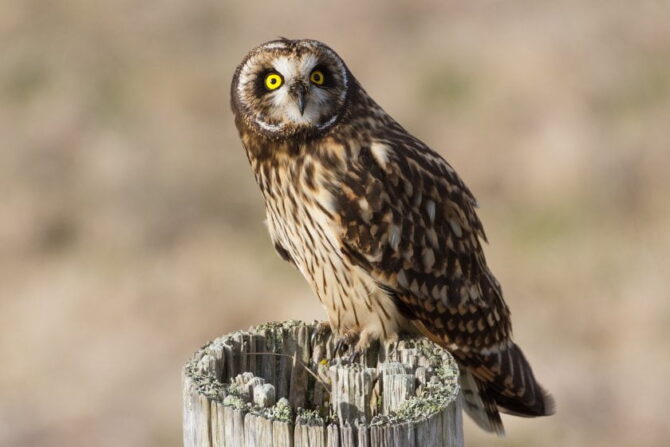
- Scientific name: Asio flammeus
- Length: 14 to 17 inches
- Weight: 7 to 17 pounds
- Wingspan: 34 to 41 inches
The short-eared owl is in the genus Asio, a group of birds known for having feather tufts on the head that are like ears.
This earned them the nickname “eared owls”. The short-eared owl has short feather tufts that are barely invisible (hence the name). It can be found in all parts of Minnesota, either all year or just for a season.
There’s more to its physical looks than the barely visible ear tufts. It is a medium-sized bird with large eyes, a short neck, a big head, and broad wings.
Added to others is a black, sturdy bill. This creature flies more like a bat than an owl due to its irregular wing beat.
Like other owls, the short-eared hunts mainly at night. However, it can be both diurnal and crepuscular.
Its preferred prey is voles, but it can also go after other animals like rabbits, shrews, squirrels, bats, muskrats, and moles.
7. Long-eared owl
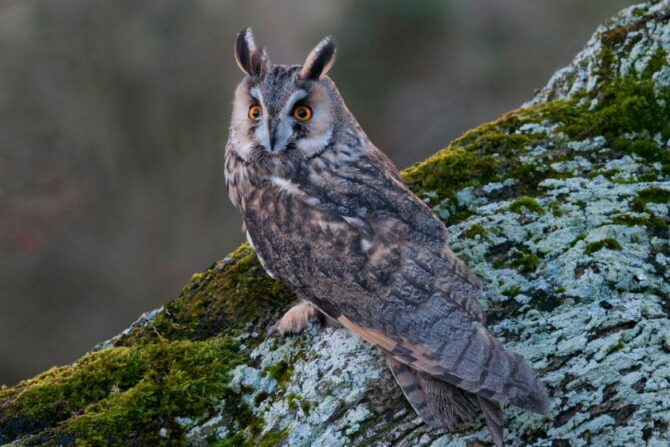
- Scientific name: Asio otus
- Length: 14 to 16 inches
- Weight: 8 to 15 pounds
- Wingspan: 36 to 40 inches
The long-eared owl is named after its most outstanding feature, the long feather tufts perched on both sides of the head.
It also has a catlike face which also gave it its second name, cat owl. Other names it is known by are the northern long-eared owl and the lesser horned owl.
It can be hard to spot in Minnesota because of its camouflage. The best way to know it is there is through sound, especially during the breeding season.
Males tend to be more talkative during that period, and the call is a soft “hoo“.
The long-eared owl can also be described as a slim bird with multiple colors like tawn, gray, and brown.
It isn’t quite sure what the ear tufts do, but the prevalent theory is that they serve as a form of communication.
These birds are quite sociable amongst themselves, unlike what we see among owls. They are nocturnal, even more than their aforementioned relatives.
They are also migratory. As hunters, they feed mainly on small mammals like rodents.
8. Snowy owl
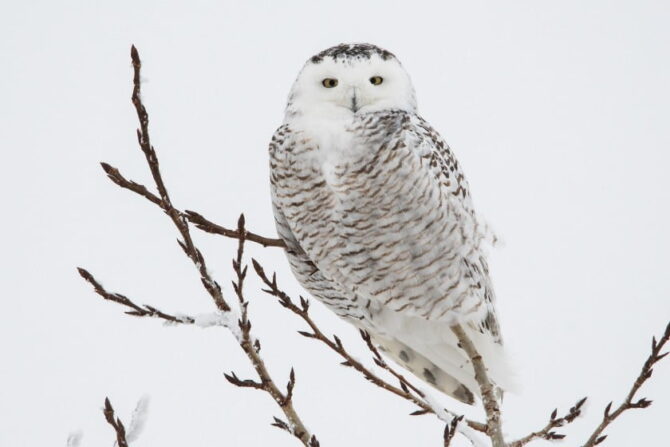
- Scientific name: Bubo scandiacus
- Length: 21 to 28 inches
- Weight: 56 to 104 pounds
- Wingspan: 50 to 57 inches
No owl is more likely to get your attention faster than white ones swooping around. Snowy owls are nomadic and do not stay in a particular area for long.
In Minnesota, these birds only appear for a particular season. They live more in the arctic tundra. They also go by some other names like the polar owl, white owl, and Artic owl.
Males tend to be whiter than females, but it is rare to see one that’s fully white. The females just have more spots which distinguish them from the male.
The males also hoot a lot, while females rarely do. Both genders employ a series of other sounds like cackles, shrieks, and snappings. These owls tend to get lighter as they grow.
Just as striking as the plumage, the snowy owl is a skilled hunter. It is usually active during the day when it does its hunting.
It feeds on small mammals, birds, and even carrion. It is considered both specialist and opportunistic. This is because it has a preferred prey but can adapt to other prey.
9. Great gray owl
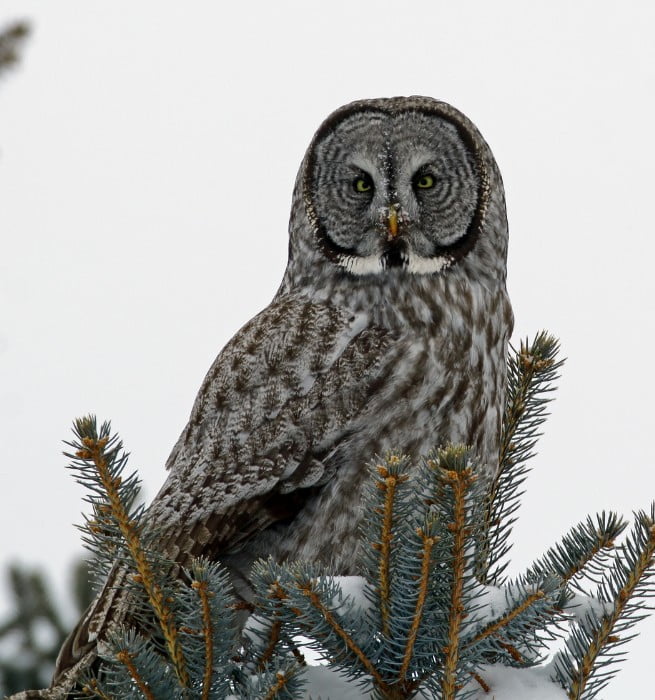
- Scientific name: Strix nebulosa
- Length: 24 to 33 inches
- Weight: 25 to 60 pounds
- Wingspan: 54 to 60 inches
The great gray owl also goes by other names like the Phantom of the North, Lapland owl, bearded owl, sooty owl, and spruce owl.
It is a very large owl and can be stunning because of its size and plumage. It lives in different parts of North America, which includes Minnesota. It is found only in the Northern parts of the state.
The great gray owl has broad wings, long tails, yellow eyes, and a gray face. The upper part is just as gray as the face, but the underside is lighter with black streaks.
Overall, one can understand how it earns the name. While it is not the weightiest bird out there, in length, it trumps many other big owl species.
The bird is as carnivorous as other species, relying a lot on rodents as a diet. Lemmings are the preferred prey, but the great gray owl can also hunt voles, hares, ducks, hawks, etc.
10. Burrowing owl
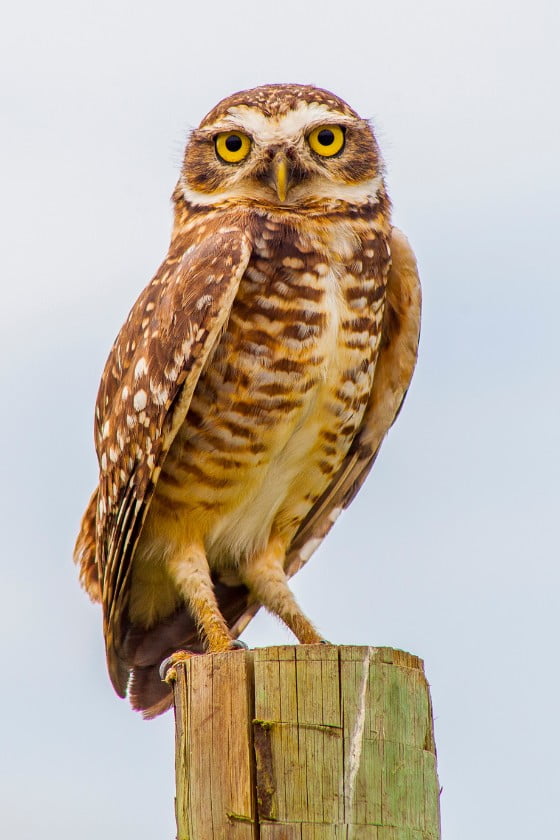
- Scientific name: Athene cunicularia
- Length: 7 to 11 inches
- Weight: 5 to 9 pounds
- Wingspan: 20 to 24 inches
The burrowing owl is so named because it lives in burrows. It can often be found in open areas like grasslands, deserts, rangelands, and many other agricultural areas.
It doesn’t dig these burrows by itself but lives in ones abandoned by other animals like prairie dogs.
In Minnesota, the burrowing owl is often found during its breeding season. It stays near the border of Western Minnesota, but when winter approaches, it moves towards the south for warmer weather.
Individuals have bright yellow eyes with a yellow beak to match, though some subspecies have a gray one instead.
Their overall color is brown and white, with the head being brown and the wings having white spots. Males and females are very similar.
This bird is often active during the day but tends to avoid the heat as it may be draining. It often hunts between dawn and dusk, making good use of its hearing to find prey.
It also has long legs that serve to pursue prey. It feeds on both invertebrates and vertebrates.
11. Northern hawk owl
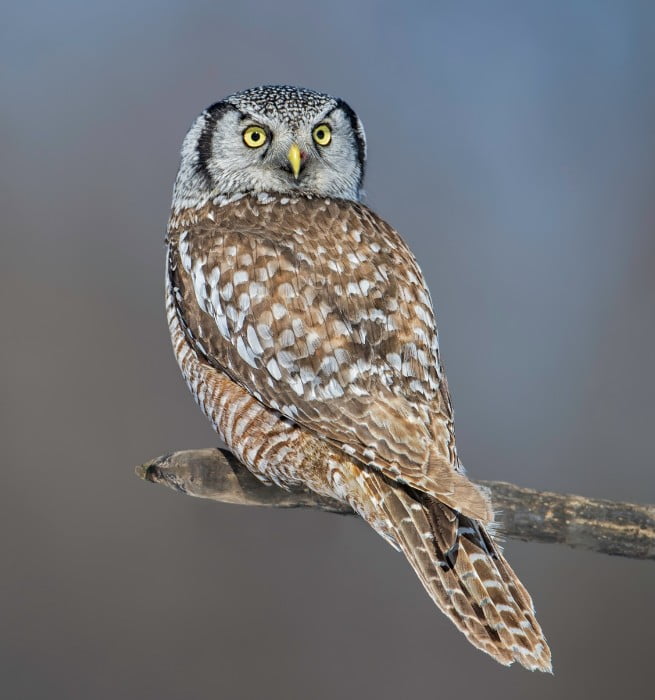
- Scientific name: Surnia ulula
- Length: 14 to 18 inches
- Weight: 8 to 16 pounds
- Wingspan: 28 inches
The Northern hawk owl has many similarities with the hawk, which makes it unique amongst owl species.
It hunts with sight, unlike its counterparts that generally come with weak eyesight. It is also diurnal and generally looks like a hawk.
It is usually located in the southern parts of Minnesota, but it is rare than many others we’ve mentioned thus far.
The country that hosts a lot of northern hawk owls is Canada. Prominent physical features include an oval-shaped body, a tail, and a stripe on the chest.
Its preferred prey is voles because of the availability, but it is not limited to those animals. Its diet comprises squirrels, hares, jays, starlings, and robins. It usually lives in coniferous forests.
12. Boreal owl
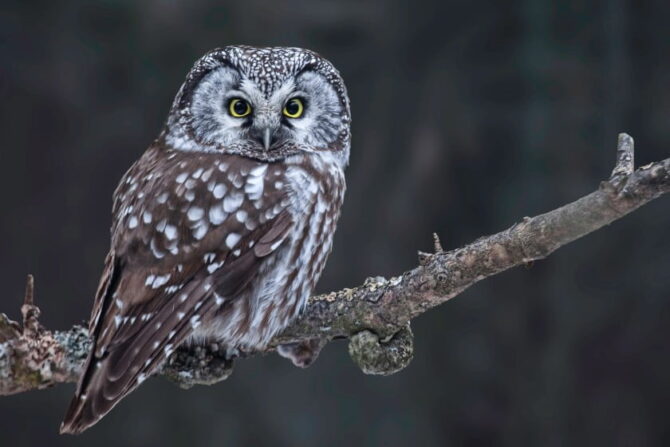
- Scientific name: Aegolius funereus
- Length: 8 to 11 inches
- Weight: 3 to 8 pounds
- Wingspan: 22 to 24 inches
The boreal owl is also called the Tengmalm’s owl in Europe, named after Peter Gustaf Tengmalm, a Swedish naturalist.
It often inhabits forests and is hard to find because of its elusive behaviors. It is also quiet for the most part. The reddish brown and gray colors further complicate issues as they can easily camouflage.
This bird can be found in the northernmost parts of Minnesota, and it occurs all year in the state.
The best time to locate this shy bird is during its breeding season. The males become more vocal during that period while searching for a mate.
The preferred diet includes voles and other smaller mammals like bats, shrews, squirrels, and gophers. It is nocturnal but not strictly so. In some places with short nights, it hunts during the day.
Conclusion
The eleven species of owls in Minnesota are among the many animals that inhabit the state. These birds of prey can either be seen at night or during the day.
They are all carnivores and strong hunters, usually going after small mammals and a host of other prey. They have their peculiarities as well, especially in color and behavior.
References & Notes
Facts Sources:
- Western Barn Owl. SANBI.
- Northern Saw-Whet Owl. Owl Research Institute.
